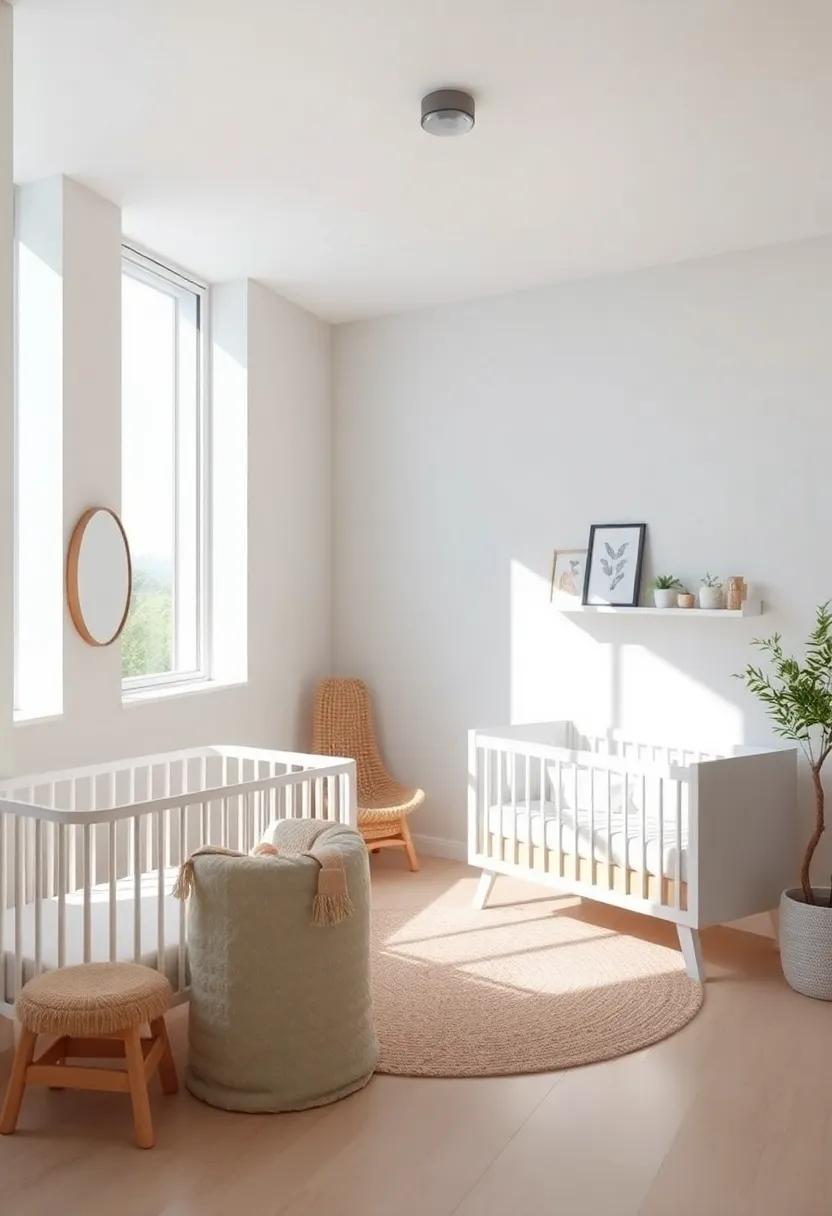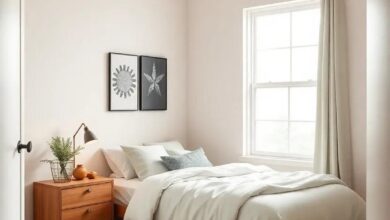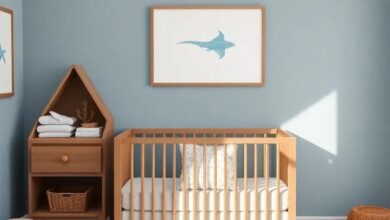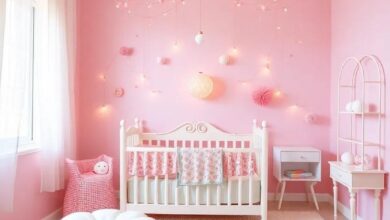
Embracing Serenity: Innovative Approaches to Modern Nursery Design
In a world that often feels chaotic and fast-paced, the quest for tranquility has seeped into every aspect of our lives, including the spaces we create for our little ones.The nursery, a sanctuary for newborns and a canvas for thier imaginations, is evolving beyond traditional design norms. “” explores the artistic and thoughtful transformations within this intimate environment, highlighting how elements of nature, minimalist aesthetics, and personalized touches can foster a sense of calm and well-being. As parents seek to cultivate a nurturing atmosphere, this article delves into the latest trends, materials, and philosophies that are redefining nursery spaces—making them not just functional, but also nurturing havens that promote peace and creativity in a child’s earliest years. Join us as we uncover the innovative strategies that unite design with the soothing essence of serenity, ensuring that every nursery becomes a place where dreams can flourish.
Embracing Natural Light and Airy Spaces in Nursery Design
Natural light is an essential ingredient in creating a serene nursery environment. By maximizing the influx of daylight, you promote a sense of calm and warmth, making the space more inviting for both baby and caregiver. Consider incorporating features such as:
- Large windows: Opt for oversized or floor-to-ceiling windows that invite the outside in and create a seamless connection with nature.
- Light-colored fabrics: Use soft shades of white, beige, or pastel colors that reflect sunlight, enhancing the brightness of the room.
- Skylights: If feasible, install skylights to flood the room with natural light, especially in spaces with limited wall openings.
Airy spaces greatly contribute to the overall atmosphere, allowing for uninhibited movement and play. Implementing open floor plans and less bulky furniture can maintain a breezy feel. it’s also beneficial to embrace elements that promote airflow, such as:
- High ceilings: These not only visually expand the room but also facilitate better airflow, keeping the nursery fresh and comfortable.
- Lightweight decor: Choose light, movable furniture and decor that can be easily adjusted to create adaptable spaces for various activities.
- Natural materials: Incorporate wood, organic textiles, and plants that not only breathe life into the space but also help enhance air quality.
creating Cozy Nooks for Relaxation and Bonding Moments
Transforming corners of your nursery into inviting retreats is essential for fostering relaxation and connection. Build a cozy reading nook by incorporating an oversized armchair or a cushioned floor mat adorned with plush cushions.This mini sanctuary can be accentuated with soft, ambient lighting, such as a floor lamp or string lights, to create a warm atmosphere perfect for storytime or quiet moments. Don’t forget to include a small bookshelf stocked with colorful children’s books to inspire curiosity and bonding between caregiver and child.
Incorporating nature-inspired elements into cozy corners can further enhance their tranquility. Bring in a touch of greenery with easy-maintenance plants like succulents or snake plants, which add a calming aesthetic while purifying the air. Consider integrating a soft rug to define the space, making it feel inviting and warm. For a creative twist, add a small side table to hold your favourite drinks or baby essentials, ensuring that this special nook is both functional and atmospheric. These thoughtful touches help create cozy environments where cherished memories can flourish.
Incorporating Biophilic Elements to Foster Connection with Nature
Integrating biophilic elements into nursery design not only enhances aesthetic appeal but also fosters a deeper connection with nature, promoting tranquility and well-being. Incorporating features such as natural light, indoor plants, and organic materials can create an atmosphere that feels both nurturing and invigorating. Consider using large windows or skylights to maximize natural light, which has been shown to improve mood and productivity. Additionally, adding live plants can purify the air while providing visual interest and a sense of life within the space.
To further enhance the natural ambience, design elements like textured wall coverings, natural wood finishes, and water features can be integrated seamlessly. These materials evoke the essence of the outdoors and create a sensory-rich environment that encourages exploration and creativity in children. Here are some essential biophilic features to consider when designing a nursery:
- Living green walls: A stunning visual element that adds texture and promotes biodiversity.
- Natural textiles: fabrics made from cotton, linen, or wool bring softness and comfort.
- Wooden furniture: Use sustainably sourced wood to provide warmth and a sense of grounding.
Exploring Calming Color Palettes for a Peaceful Nursery Environment
Creating a calming environment in a nursery starts with the right color palette. Soft,muted tones inspire tranquility and warmth,transforming an ordinary room into a soothing retreat. Consider using shades like pastel blues, gentle greens, and soft pinks to create a harmonious space that promotes relaxation. These colors, inspired by nature, not only enhance the aesthetic appeal of the nursery but also contribute to a serene atmosphere, helping your little one drift to sleep with ease.
To further refine your color choices, explore color pairings that evoke peace and stability.here are some suggestions for complementary colors to enhance your nursery’s calming vibe:
- Pale Blue with Soft Gray
- Mint Green and White
- Lavender paired with Peach
- Dusty Rose and Contracting Soft White
Consider utilizing a color wheel to visually capture the relationships between these calming colors. Applying these combinations on furniture, decor, and textiles ensures that every corner of the nursery embodies serenity and comfort. Below is a simple reference to how these hues can be organically integrated into your nursery design:
| Color | Intended Mood | Recommended Use |
|---|---|---|
| Pale blue | Calm and Rest | Wall Color |
| Soft Grey | Balanced and Secure | Furniture Accents |
| Mint Green | Freshness | Textiles |
| Lavender | Peacefulness | Decorative Elements |
Selecting Sustainable materials for Eco-Friendly Nursery Spaces
Creating an eco-friendly nursery begins with the careful selection of sustainable materials that enhance the overall ambiance while promoting health and safety for your little one. Natural fibers should be a primary consideration; options such as organic cotton, bamboo, and linen are not only soft and breathable but also free from harmful chemicals. Additionally, opting for low-VOC (volatile organic compounds) paints and finishes can substantially improve air quality, making the nursery a haven for both parent and child. when choosing furniture, look for pieces made from reclaimed wood or sustainably harvested timber, which not only reduces environmental impact but also adds a unique, rustic charm to the space.
Incorporating elements like recycled or eco-friendly materials into décor can also play a vital role in enhancing the nursery’s sustainability. Consider items such as rugs made from recycled plastics or curtains produced with organic dyes. Integrating plants into the nursery can further purify the air and bring nature indoors; select species that are non-toxic to children. To help you visualize the options, here’s a simple comparison of sustainable materials:
| Material | Benefits |
|---|---|
| Organic Cotton | Soft, breathable, and chemical-free |
| Bamboo | Fast-growing, antibacterial, and biodegradable |
| Recycled Plastic | Durable and eco-friendly for carpets and decor |
| Reclaimed Wood | Reduces waste and offers unique character |
Innovative storage Solutions to Keep the Nursery Organized and Serene
Creating a tranquil nursery goes hand-in-hand with implementing smart storage solutions that promote an organized environment. consider incorporating multi-functional furniture that provides both aesthetic appeal and practical storage capabilities. For instance, a charming crib with built-in drawers can neatly hide away essentials like bedding and extra clothes, while a changing table designed with shelves can keep diapers and wipes easily accessible. You can also explore open shelving systems adorned with decorative baskets to encourage easy institution and retrieval of toys, books, and supplies, seamlessly integrating practicality with an inviting ambiance.
To further enhance tranquility, invest in customized storage solutions that cater to your specific needs. Design a cozy reading nook with a spacious, low bookshelf that invites little ones to choose their own books, fostering independence and organization. Pair it with cozy bean bags or cushions for a serene reading experience. For art supplies and crafting materials,consider a rolling cart that can be easily moved from room to room,allowing creativity to flow without cluttering your space. Below is a simple overview of potential innovative storage solutions:
| Storage Solution | Benefit |
|---|---|
| Multi-functional Crib | Maximizes space while storing essentials |
| Open Shelving with Baskets | Encourages easy access and organization |
| Customized Low Bookshelf | Promotes literacy and independence |
| Rolling Art Cart | Makes creative projects portable and organized |
Designing Multi-Functional Furniture for Flexibility and Comfort
Creating a modern nursery that embodies both comfort and versatility involves leveraging innovative furniture designs that cater to the evolving needs of both parent and child. Multi-functional pieces, such as cribs that convert into toddler beds or changing tables that double as storage units, can maximize space while ensuring a serene environment. This flexibility allows parents to adapt their space as their child grows, fostering a sense of continuity and balance. Consider incorporating items with embedded technology, such as a rocking chair with Bluetooth speakers for soothing music, or modular shelving that can change configurations over time.
To achieve a harmonious aesthetic, materials and color schemes play a pivotal role. Calming palettes can enhance the tranquil atmosphere, making it easier to create a nurturing space. Choose furniture crafted from sustainable materials, adding to both the eco-friendliness and durability of the nursery. Some design options include:
- Convertible Cribs – Transition seamlessly from crib to toddler bed.
- Storage Ottomans - Perfect for keeping toys organized while providing extra seating.
- Wall-Mounted Desks – Space-saving workstations that can be removed as needed.
| Furniture Type | Functionality |
|---|---|
| Changing Table | Converts to a desk post-nursery |
| Crib Sofa | transforms into a comfortable seating option |
| Play Mat | Turns into a storage bag for toys |
Infusing Personal Touches with Customized Decor and Artwork
Transforming a nursery into a serene haven goes beyond selecting soft colors and cozy furniture; it’s about adding personal touches that resonate with your family’s journey. Customized decor offers a unique way to celebrate milestones and memories, whether through a bespoke mural that depicts a special story or personalized wall hangings that feature quotes or messages. Consider incorporating elements such as:
- Framed family photos integrated into the decor
- Handmade crafts from family members or friends
- Custom baby name signs that capture the essence of your child’s identity
Artwork plays a crucial role in setting the mood; opt for pieces that evoke calmness and joy. An eclectic mix of colors can awaken the space, so think about introducing local artists’ work or even commissioning a piece that reflects your cultural heritage. Below is a simple table showcasing some ideas for customized artwork:
| Artwork Type | Customizable Elements |
|---|---|
| Canvas Prints | Name and birth date |
| Wall Murals | Theme and color palette |
| Mobile Art | shapes and colors |
| Customized Stories | Illustrations based on family tales |
Creating Interactive Spaces for Learning and Play experiences
Designing environments that foster both learning and play is essential for the advancement of young minds. By incorporating interactive elements, we can create spaces where children are encouraged to explore, discover, and engage with their surroundings. Consider implementing these features:
- Modular furniture: Pieces that can be rearranged to form different configurations inspire creativity and teamwork.
- Interactive walls: Chalkboard or whiteboard surfaces allow for spontaneous artwork and idea sharing.
- Outdoor-indoor connections: Easy access to gardens or play areas promotes exploration and a love for nature.
Additionally, technology can seamlessly integrate into these spaces, providing endless opportunities for growth. Some notable tools include:
| Technology Tool | Purpose |
|---|---|
| Interactive Tablets | Encourage learning through educational games and apps. |
| Augmented Reality | Enhances storytelling and play experiences. |
| Digital Art Stations | Fostering creativity through digital drawing and animation. |
Integrating Soft Textures to Enhance Comfort and Relaxation
Incorporating soft textures into a nursery can transform the space into a serene oasis, promoting a sense of comfort and relaxation. The tactile sensations created by various materials can soothe both babies and parents, making the nursery a haven for calm. Consider integrating:
- Plush Rugs: Soft area rugs not only add warmth underfoot but also create a cozy play space for little ones.
- Cotton or Bamboo Fabrics: Using breathable,gentle fabrics for bedding and curtains ensures a tranquil atmosphere.
- Textured wall Hangings: soft wall decor can absorb sound and create a peaceful environment.
When selecting items, variety in texture can play a crucial role in enhancing the nurturing vibe of the room. Layering different materials can also increase visual interest while maintaining a soft feel. Explore options like:
| Texture Type | Material Examples |
| Soft | Velvet, Chenille |
| Natural | Cotton, Linen |
| Warm | Wool, Faux Fur |
By mindfully choosing these elements, you can curate a soothing atmosphere that not only nurtures but also inspires joyful moments of connection between you and your child.
utilizing Sound dampening Techniques for a Tranquil Atmosphere
Creating a serene environment in a nursery involves more than just choosing the right colors and decor. one effective method to achieve a tranquil atmosphere is through the use of sound dampening techniques. These techniques not only reduce noise pollutants but also contribute to a soothing environment conducive to rest and play. Consider incorporating:
- Acoustic Panels: Available in various styles and designs, these panels can be strategically placed on walls or ceilings to absorb sound.
- Soft Furnishings: Adding plush cushions, rugs, and drapes can significantly muffle ambient noise while enhancing comfort.
- Soundproofing Foam: This material can be used in specific areas,notably around windows and doors,to minimize external disturbances.
Additionally, planning the layout carefully can optimize sound flow and create pockets of calm. Consider using a sound barrier approach by positioning larger furniture items like bookshelves or cabinets along shared walls. The following table illustrates how different materials contribute to sound absorption,helping you make informed design choices:
| Material | Sound Absorption Rating |
|---|---|
| Cotton Fabrics | Medium |
| Wood Panels | Low |
| Carpets | High |
| Acoustic Tiles | Very High |
Incorporating smart Technology for Effortless Nursery Management
Integrating smart technology into nursery management optimizes workflow and enhances the overall experience for both caregivers and children. Through the use of advanced systems, nursery professionals can streamline tasks and monitor various aspects of the environment. Smart thermostats, automated lighting, and air quality sensors provide real-time data, ensuring that the nursery environment remains comfortable and conducive for learning and play. Additionally, apps designed for childcare scheduling and attendance tracking can significantly reduce administrative burdens, allowing staff to dedicate more time to nurturing children’s growth and development.
Moreover, the incorporation of safety features such as smart cameras and alarm systems brings peace of mind to caregivers and parents alike. These technologies enable seamless interaction and provide immediate updates on classroom activities through mobile notifications. As an example, a dashboard can visually represent the nursery’s performance metrics, including attendance trends and staff schedules, allowing for proactive planning. By fostering connection through technology, nurseries can create a harmonious environment that prioritizes both the well-being of children and the efficiency required in modern childcare.
Designing Safe Zones for Uninterrupted Play and Exploration
Creating spaces where children can play freely and explore their surroundings is essential for fostering creativity and encouraging healthy development. To achieve this, modern nursery designs must incorporate open layouts that provide ample room for movement while ensuring safety at all times. Utilizing natural materials, such as wood and low-VOC paints, not only contributes to a calming atmosphere but also minimizes harmful chemicals in children’s environments. Additionally, integrating soft, textured rugs can define play areas and cushion falls, helping to establish boundaries while enhancing comfort during playtime.
To enhance the overall experience, consider implementing sensory zones that captivate children’s interest and stimulate their imaginations. Elements such as water play stations, nature-themed murals, and outdoor exploration areas not only enrich their surroundings but also promote sensory development.To further encourage autonomous exploration, it is indeed beneficial to use modular furniture that can be easily rearranged, allowing children to adapt their environment to their play needs. Here’s a quick overview of essential features for designing these safe spaces:
| Feature | Purpose |
|---|---|
| Open Layout | Encourages movement and social interaction |
| Natural Materials | Promotes a healthy atmosphere |
| Sensory Zones | Stimulates curiosity and creativity |
| Soft Textured Rugs | Provides comfort and safety during play |
| Modular Furniture | Facilitates adaptability and independence |
Balancing Aesthetics and Functionality in Nursery Layouts
Creating a nursery that appeals to the eye while serving a practical purpose is an adventure in design. striking a balance between aesthetics and functionality requires thoughtful planning and innovative ideas. Consider incorporating multi-functional furniture such as cribs that convert into toddler beds or storage solutions that double as decorative elements. This approach not only optimizes space but also enhances the overall visual appeal. Moreover, a cohesive color palette can tie the room together, creating a soothing environment conducive to rest and play.
Along with furnishings, the layout of the nursery plays a crucial role in its effectiveness. It’s essential to design flow and accessibility within the space, ensuring that everything is within reach yet organized. Implementing a zoned layout can help define areas for sleeping, changing, and playtime. Consider these elements to enhance design:
- Natural Lighting: utilize window treatments that diffuse light while providing privacy.
- Soft Textiles: Incorporate rugs and curtains that contribute to a warm atmosphere.
- Personal Touches: Add family photos or soft artwork that reflects your style while being non-intrusive.
Harnessing aromatherapy to Promote Calmness in the Nursery
Incorporating aromatherapy into nursery design can be an innovative way to cultivate a tranquil environment that supports both caregivers and little ones.By utilizing essential oils known for their calming properties,such as lavender,chamomile,and bergamot,parents can create a soothing sensory experience. Consider integrating these scents through:
- Diffusers: These can quietly disperse calming aromas throughout the nursery, enhancing the overall atmosphere.
- Aromatherapy pillows: Soft fabric infused with essential oils can be placed in cribs or sleeping areas.
- DIY linen sprays: A gentle mist over bedding or soft toys can offer a refreshing and calming touch, promoting relaxation during nap time.
Creating a serene space goes beyond aroma; it’s essential to understand how each scent can influence mood and behavior.Below is a simple table outlining common essential oils and their calming benefits for children:
| Essential Oil | Calming Benefits |
|---|---|
| Lavender | Reduces anxiety, promotes restful sleep |
| Chamomile | Alleviates restlessness, soothes irritability |
| Bergamot | Enhances mood, reduces tension |
Designing Open Spaces to Encourage Freedom of Movement
Creating dynamic environments in nurseries involves thoughtful design that promotes freedom of movement for children. By prioritizing open spaces, designers can foster an atmosphere that encourages exploration and play. Key elements to consider include:
- Flexible layouts that adapt to different activities, allowing for both energetic play and quiet contemplation.
- Zoned areas that define specific activities—such as a reading nook, art corner, or climbing zone—while still maintaining a sense of openness.
- Natural materials that not only provide tactile experiences but also contribute to a calming ambiance in the space.
Furthermore, implementing design strategies that facilitate easy navigation enhances independence in young children. Consider incorporating:
- Wide pathways that eliminate barriers, enabling children to move freely between activity areas.
- Adjustable furniture that accommodates various ages and sizes, promoting inclusivity and comfort.
- Transparent partitions that visually connect different areas, allowing children to see and engage with one another while maintaining a safe distance.
Creating Visual harmony with Thoughtful Pattern Combinations
Designing a nursery involves much more than just selecting colors; it’s about creating an environment that fosters peace and creativity. Thoughtful combinations of patterns can elevate the space, making it visually stimulating yet serene. To achieve this, consider contrasting organic and geometric elements that balance each other beautifully. Patterns can be strategically layered to create depth without overwhelming the senses. For instance, pairing soft, nature-inspired fabrics with playful, geometric prints allows for a harmonious blend that sparks imagination while maintaining tranquility.
When integrating various patterns, consider the following principles to maintain visual equilibrium:
- Scale Variation: Mix large-scale patterns with smaller ones to create an engaging visual dialog.
- Color Cohesion: Ensure that the color palette across different patterns shares common hues, promoting a unified look.
- Texture Play: Incorporate materials that vary in texture, such as soft cottons with slightly rougher linens to add tactile interest.
this mindful approach not only enhances the aesthetic appeal but also contributes to a calming atmosphere, supporting the overall goal of a nurturing space for your child.
Curating Engaging Display Areas for toys and Books
Creating captivating display areas for toys and books transforms the nursery into a vibrant space that encourages exploration and learning. The key lies in combining aesthetics with functionality, so parents can easily access and organize these treasures. consider using open shelving to showcase colorful toys and beautifully illustrated books,allowing little ones to engage visually. Incorporate playful elements such as baskets or fabric boxes that both organize and add texture to the space. For a touch of whimsy, integrate themed decor that reflects the nursery’s overall style while promoting creativity and imagination.
To enhance engagement, highlight specific pieces by creating mini “showcase” sections. This can be achieved through:
- Rotating Displays: Change the toys and books periodically to keep the area fresh and exciting.
- Themed Areas: Dedicate spaces for specific topics, like a nature corner with books about animals.
- Interactive Features: Use chalkboard paint or magnetic strips where children can stick their favorite pieces.
These thoughtful touches transform mere storage into inspiring focal points, sparking curiosity and imaginative play as children explore their surroundings.
Enhancing Nursery Flow Through Strategic Furniture Placement
Creating a nursery that not only looks beautiful but also facilitates smooth flow is essential for a tranquil environment.By strategically placing furniture, parents can enhance mobility, making it easier to attend to the little one’s needs. Consider the following tips for an optimized layout:
- Designate zones for sleeping,playing,and changing to clearly define areas of activity.
- Arrange furniture to create clear pathways, avoiding clutter that could hinder movement.
- Utilize multi-functional pieces, such as a crib that converts into a toddler bed, to maximize both space and usability.
Additionally, it’s crucial to think about the visual appeal of the nursery and also its functionality. For instance,positioning a cozy rocking chair near the window can transform it into a serene reading nook while allowing parents to keep an eye on their baby. An excellent way to visualize the space is to create a simple table that outlines furniture placements and their intended purposes:
| Furniture Item | Purpose | Ideal placement |
|---|---|---|
| Crib | Sleeping | Corner with soft lighting |
| Changing Table | Diapering | Near the closet for easy access |
| Rocking Chair | Feeding & Relaxation | Adjacent to the window |
Fostering a Sense of Security with Well-Planned Lighting Solutions
Creating a sanctuary for little ones goes beyond the aesthetics of nursery décor; it involves careful consideration of how lighting influences their environment. Implementing a thoughtfully designed lighting scheme can profoundly impact a child’s sense of security and comfort. Consider using a layered approach that combines ambient, task, and accent lighting to adjust the atmosphere throughout the day.For instance, soft, warm lighting can create a cozy atmosphere during bedtime, while brighter, adjustable options can be used for playtime and activities, promoting engagement and creativity.
To optimize safety and tranquility,strategically placed fixtures and innovative smart lighting technology can enhance the overall experience. by integrating features such as dimmers and night lights, parents can easily adapt the brightness to meet their child’s needs at different hours. Key elements to consider include:
- Soft colors: Utilize warm hues to evoke a calm ambiance.
- Adjustable intensities: Allow for flexibility from reading lights to soothing night illumination.
- Motion sensors: Install lights that automatically adjust based on movement to enhance safety during nighttime visits.
By harmonizing these components, parents can create an environment that is not only aesthetically pleasing but also nurturing, supportive, and conducive to peaceful rest and play.
In Retrospect
As we’ve journeyed through the tranquil realm of modern nursery design, it’s clear that embracing serenity is not merely a trend but a necessity in today’s fast-paced world. The innovative approaches highlighted in this article remind us that a nursery is more than just a space for sleep; it is indeed a sanctuary where nurturing and creativity can flourish in harmony. By blending sustainable materials, thoughtful layouts, and calming color palettes, parents can create an environment that promotes peace and joy—the bedrock upon which childhood memories are built.As you embark on your own design adventure, consider how each element can contribute not only to aesthetic beauty but also to a profound sense of calm and connection. Embrace the journey ahead,and let your nursery become a cherished haven for both child and caregiver alike.
As an Amazon Associate I earn from qualifying purchases.























